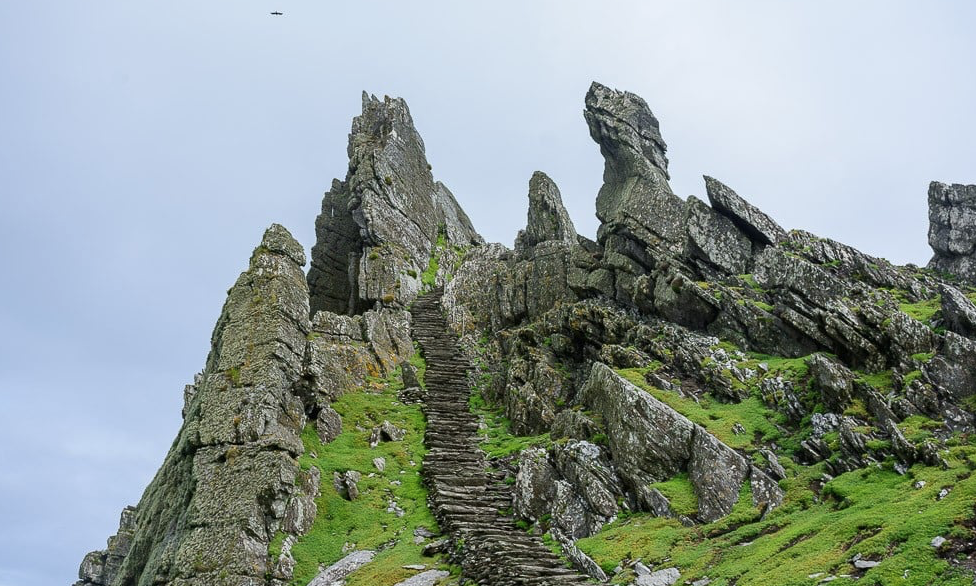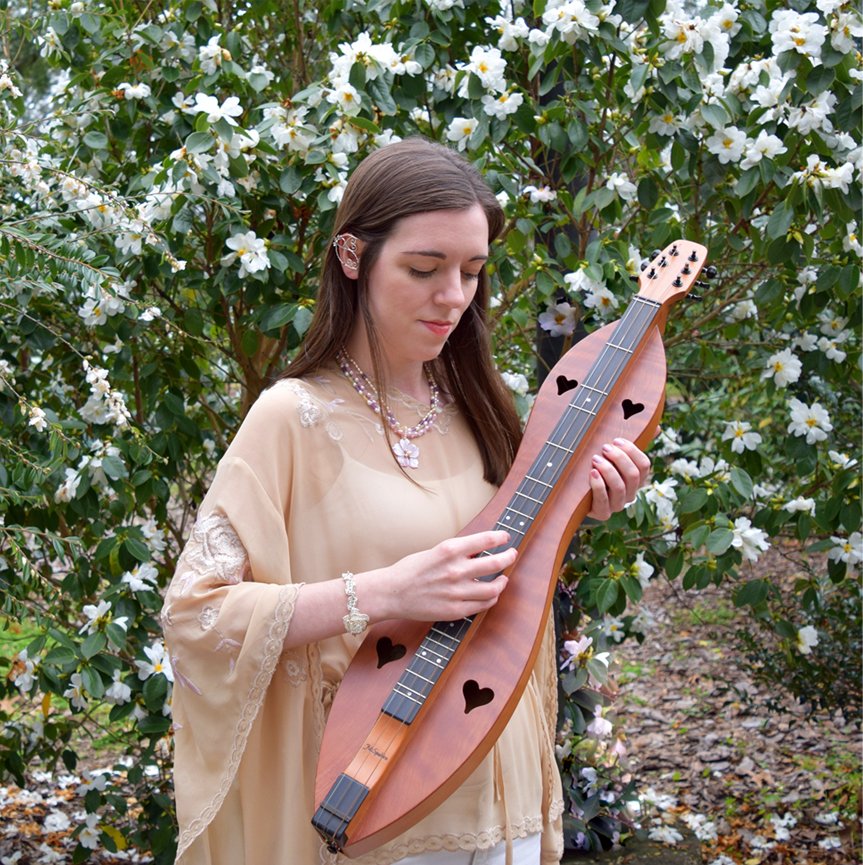
not all those who wander are lost
by Victoria Thomas
“The world is indeed full of peril, and in it there are many dark places; but still there is much that is fair, and though in all lands love is now mingled with grief, it grows perhaps the greater.”
-J.R.R.Tolkien, The Fellowship of the Ring
We live in liminal times.
The word “liminal” comes to us from the Latin, “limen”, meaning threshold, or place in-between.
Jessica Comeau is an inspired composer, instrumentalist and singer who dwells in liminal spaces, accompanied by her mountain dulcimer which she plays by ear. Speaking with her via Zoom in her hometown of Pensacola Florida, she explains that she’s an “old soul.” She continues, “Making music really is a spiritual experience. As I see it, during the musical creative process, you, the musician, are the instrument that brings the emotions and visions to the surface, rather than the specific tool you use to do that. When you have a good instrument that responds to you, then you can explore the story and the sounds in an interior way. When composing or playing something in a heartfelt way, you are participating in the story: you are a part of it. Music-making itself is a liminal space between the imagination and the outer realities.”
Comeau began writing music by age 10 or 11, and describes herself as an introvert. She adds, “What has always intrigued me most are the spaces between the notes. The way blues singers hit sounds that fall outside the written notation, because they can’t be written down.” She cites medieval melodies (“for their modal character”), the Chieftains, Enya, Loreena McKennitt, and even Bing Crosby as musical influences.
Musician/novelist David Crittendon, author of the new novella, “Then See If I Care: A Story About Bessie Smith”, makes a comparison to the singing of the Empress of the Blues, Bessie Smith, in this way: “Blues music initially found much of its rhythm and chord progressions in the spirituals and ‘Negro’ work songs from the days of slavery. After the Civil War, however, blues songs gained a more sophisticated structure, often in twelve-bar form. Bessie’s interpretations of her favorite blues songs were innovative, not only because of her great projection, but also because she sang differently from other singers, bridging the gaps between major and minor notes with a kind of blue half-note. She called this ‘singing in the cracks’, or the spaces between notes. It is within those spaces that the greatest power of the music rests.”
While Jessica Comeau’s ethereal presence – she focuses on the “Good in Everything”-- seems far removed from the rough revival-tent shouting and fierce, give-me-a-pig foot-and-a-bottle-of-beer sonics of Bessie Smith, they are kindred in that their music transports and transforms both the singer and the listener.
Just as the classic blues form consists of repeated elements of lyric and melody, energized by expressive vocal and instrumental variations, Comeau’s music seems improvised, even when it’s not. Derived largely from the rich legacy of Celtic and Appalachian music, many of the compositions that Comeau performs employ an element called a drone.
While “droning on” may trigger a negative association in English usage, this stabilizing anchor-note of the drone is essential to the instantly recognizable aural environment created by the genre. This drone element is what our ears register first when we hear bagpipes, dubbed “the agony-bags” by unappreciative Britons. Not coincidentally, both the bagpipes and the mountain dulcimer (there are many variations in design and construction, all with common roots) find their origins in the music of Greece and Persia, circa 1000 CE. Perhaps it is this audible echo of foreign antiquity that give both instruments their bewitching strangeness.
This dissonant quality is vividly present in the folk music sounds of the Great Smoky Mountains, coal-country, Kentucky and Tennessee in particular. It’s what Bill Monroe called “the high lonesome sound,” and it’s what gives Dolly Parton’s classic “Joleen” its chilling, tonal ache.
Listening to Comeau’s recordings, particularly her arrangements of works like “Cantiga 26: Non é gran cousa”, even the crustiest moderns among us may get glimmers of fey faerie-dells, of an enchanted sword issuing from the mists of an ancient lake, and of the fearsome and fabled seal-human changelings of Scotland’s Orkney Islands called Silkies. The Cantigas de Santa Maria take Comeau from her Celtic focus to medieval Portugal and Galicia, where the Cantigas, or Canticles of Holy Mary, were written during the reign of Alfonso X of Castile El Sabio (1221-1284 CE). The Cantigas are a collection of 420 poems, relating Marian miracles.
“It all begins with a story for me,” says Jessica, who teaches developmental reading and writing when she’s not recording, touring, performing, and offering dulcimer workshops. “It has to do with my relationship with time. Storytelling and narrative are a form of time-travel, and so these stories are for me what are called ‘thin places’ in Ireland, ‘thin’ places meaning where the membrane between the seen world and the unseen worlds becomes permeable and thin enough to cross through.”
The artist says, “I have both French and Irish (and other) heritage, and consequently Catholic and pagan ancestry on both sides. It has taken me some time to figure out how to relate to these apparently contradictory realities and influences, but in the end, like C.S.Lewis and Tolkien, I have found God to be deep and wide enough to contain it all, even the truth, beauty, and goodness evident in pre- and non-Christian culture. My song “Good in Everything” probably is the best expression of that philosophy.”
She describes her own compositions as “…an elegant bridge between traditional folk music and more modern songwriting,” adding that she places special value on “hidden layers of meaning.” Her album “Fantasy Music with an Acoustic Heart” creates these layers by pairing her standard and baritone mountain dulcimers with angel wing harp keyboard and voice. Comeau’s repertoire is contemplative, often moving from a melancholy, minor-note introduction into a blissful resolution in a major key. This format of a pensive musical journey culminating in a comforting, healing conclusion gives visceral credence to the theory of sound-healing therapies and how music can influence us on a cellular level. Science affirmed long ago that all life at its core exists as vibrating atoms, and thus music including Comeau’s perhaps alters our brain-wave patterns from Beta (anxiety, fight-or-flight reflex) to calmer frequencies known as Alpha (relaxation), Theta (meditation), and Delta (trance-like state).
A harmonic tool known as a plagal cadence– even casual music-listeners will recognize the two notes of “Amen” sung at the end of virtually every Christian hymn, these two notes being plagal – saturate Comeau’s music with a sensuous gravity. This cadence is, for instance, the characteristic arrangement of notes that gives plainsong and Gregorian chant its subdued majesty.
The coming of spring, signaled by the vernal equinox on March 20, has long been considered a “thin” place in world culture. The constellations shift, and our ancestors believed that their human fortunes followed the movements of the planets and stars. While traditional Christians have observed Lent as 40 days of penitence and fasting, the literal word itself, “Lent”, is far more pleasant view of the season. “Lent” is the derivation of two Anglo-Saxon words, “lencten” (sounds like “lengthen”) and “lenctentid”, meaning spring and “springtide”, and cognates in other Indo-European words reference the lengthening of days beginning with the equinox. These Lenten words also often reference the month of March, when the equinox tends to fall.
The Feast of St. Patrick on March 17 has quite predictably been greeted with gladness for more than 1000 years in the Western world. In even the most devoutly observant Catholic congregations, St. Patrick’s Day historically offered a day-pass from the Lenten rigorous prayer and fasting which ends on Easter morning, strictly speaking. After morning Mass, families in Ireland and beyond would celebrate their patron saint with a feast of cabbage and bacon (meat being prohibited during Lent), dancing, and yes, knocking back a few pints (alcohol also being expressly forbidden as well). This, too may be interpreted as a spring-like resurrection of ease, happiness and joy after the austerity of a second winter in the form of Lenten observance.
The study of the lives of the saints, called hagiography, is especially colorful when it comes to the life of Saint Patrick. Historians agree that Patrick was a real person, born in 5th century Roman Britain, captured by Irish pirates during a raiding party, forced into slavery (more than once), and sent to Ireland at age 14 to labor as a shepherd. After years of hardship, exile, and study, he was ordained as a priest, and anointed as a Bishop by Pope Celestine in the year 432 CE, when he arrived in Ireland once again, this time with the mission of spreading the Gospel and converting the local heathens to the Christian faith.
Patrick is hilariously credited with driving the snakes out of Ireland, but there’s just one thing: according to National Geographic, there were never any snakes on the Emerald Isle for the saint to banish, according to the fossil record. The most recent Ice Age kept the island too cold for reptiles, which need exposure to hot sun to survive.
Following the end of the Ice Age about 10,000 years ago, the shivery waves of the surrounding ocean were too frigid to lure any sea-serpents toward the Irish coast. Perhaps this charming bit of blarney is a metaphor for Patrick driving Druids and other pagans into the recesses of memory, and converting the people of Ireland to Christianity as symbolized in the shamrock, for the three-personed Trinity of Father, Son and Holy Ghost.
St. Patrick’s Day is often the only day of the year that many people hear what might loosely be called Gaelic music, or Celtic music, often introduced by the braying skirl of bagpipes. As such, it’s no more than a moment – when this year’s new limited-edition Lucky Charms cereal turns your milk green, and when we may hoist a few bright green ales (“the freshest of food and the oldest of drink”, as they say in Ireland) in honor of a saint who may seem as improbable and removed from our lives as St. Nick or St. Valentine.
Jessica Comeau’s music, true to form, travels into the hidden spaces and thresholds that the holiday’s music and myths serve up. She writes that her work “…embraces an aesthetic of natural wonder: both wonder at nature and wonder as a natural response to Truth, Beauty, and Goodness. This aesthetic sees quirks and what some might call imperfections as part of the beauty of an individual being: the ancient oak is more, not less, beautiful because it is gnarled, knotty, and covered in lichen. Thus, life can be both down-to-earth and otherworldly at the same time. My songs are another language with which to speak about what it is to be human: to have both body and soul, to be a part of both earth and heaven while walking through this ‘middle-earth.’ My hope is that these songs will draw you into imaginative spaces in which to experience healing, acceptance, and an escape to Reality.”
Listening to this young artist offers us a rare opportunity to enter a doorway, a portal, a threshold place where perhaps we can reach into another dimension of faith, of self, of being, with each note burnished, cherished, chosen, and arrayed like the vintage and repurposed beads that Jessica Comeau uses to create unique rosaries, when her gifted hands and voice are not summoning wonder from heavenly heights, forest silence, and her own incandescent depths.
Images courtesy of Jessica Comeau, PIXELS, and UNSPLASH.




